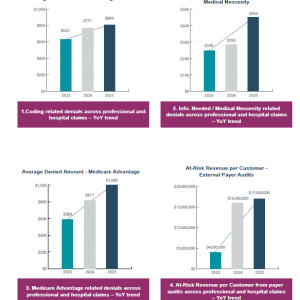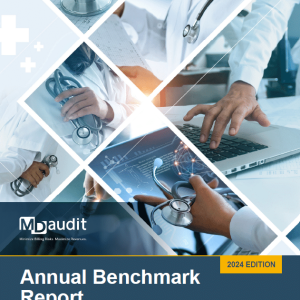Driven by payers who have upped their audit game, many large healthcare systems are disadvantaged due to a lack of cohesion in software. Whether due to mergers, siloed departments, or other reasons, these organizations have grown accustomed to utilizing multiple applications and software and, as a result, are not reaching their full financial potential.
The ramifications of having various software are not always so obvious. Here, we look closely at the consequences of not having a singular platform for billing compliance and revenue integrity and what you can do to remedy such a situation.
Unable to Unify Procedures and Break Down Departmental Silos
Billing compliance and revenue integrity go hand-in-hand, so it makes perfect sense to have a singular platform to combine efforts. Unfortunately, many healthcare systems are still operating with siloed departments utilizing several software, or sometimes none at all.
A recent study revealed that about 40% of healthcare finance and revenue cycle executives still rely on spreadsheets to track denials and audits. Less than a quarter are even tracking trends. By not integrating technology, they are not only leaving money on the table that could be retained, but they also may not even be getting back all the money they’re owed.
These two vital departments, among others, should be unified. The right software puts them on the same page – avoiding overlap, working from the same data, identifying the same risks, and working together to mitigate and monitor them. If healthcare systems don’t have one source of truth that points to outliers and anomalies, it’s almost impossible for human effort to detect who or what in the organization could be putting it at risk. Reducing the risk of human error is another major advantage of having a cohesive platform.
Haphazard Auditing & Revenue Retention Structure
Compliance and revenue integrity software can help lighten the load by automating many of the technical aspects of daily work. Streamlining audit workflows helps to maintain operational efficiencies and sets the compliance department on a path to success. The right software will dictate where auditors need to spend more time. More importantly, implementing software that automates audits leaves more time for other crucial efforts, such as provider and coder education.
From a revenue perspective, having the right technology can help mitigate denials by analyzing remit data by revealing what’s being frequently denied by payers and why, and what the financial implications are of such denials. This data is priceless to revenue C-suite leaders. Because payers tend to lag in terms of payments, it makes an even stronger case to submit cleanly the first time.
According to MDaudit research, each denial costs an average of $300 per professional claim, while hospital claims average out at double that amount for outpatient and an astounding $5,800 for inpatient claims. The idea that many healthcare organizations are still lax in implementing revenue integrity software speaks volumes about 2022 being the worst financial year for hospitals since the pandemic.
No Structure in Analytics
Reliance on the IT team to pull data greatly slows down processes and progress for billing compliance and revenue teams to get ahead. It simply takes too much time, and you are at the mercy of the IT team’s schedule and when they can deliver data. IT teams should be freed up to focus on their own tasks.
Instead of manually stringing together data from various sources, having a singular platform that gathers information from different areas and collates it for you to drill into, more accurately informs your decision-making, and in turn, helps grow revenue.
The right software will provide billing data to analyze so professionals can minimize errors on the front end of the cycle, lessen days in A/R, and improve overall revenue. The same goes for denial data, wherein auditors can inspect recurring errors and prevent them from a systemic standpoint.
Looking into auditing data can reveal which providers and coders are at risk for repeated errors, and can identify those who are in need of corrective action. Another crucial data point is that of payers, and identifying what went wrong after claims are submitted to learn from mistakes and avoid repetition.
There is simply no way for any person to be responsible for gathering all this information accurately and delivering it to the proper hands. Having structure in analytics is best performed by technology that can collate and offer drill-down data to identify risks and offer the time and opportunity to make systemic changes – at the root of the problem.
Your C-Suite Demands Cohesion & Accountability
Reporting capabilities are one of the major outputs of a solid platform. Your C-suite depends on them to dictate the next steps and how to move forward best. The only way to properly report successes and failures is via software that can collect and organize data, and then churn out information in a cohesive story that demonstrates which and how departments and individuals are performing.
Another vital justification for having a powerful, singular platform is its financial impact. The monetary benefits of implementing a robust platform will present themselves almost immediately. Within just 6 months of implementing MDaudit, a Texas-based healthcare system was able to identify the following:
- Charges audited: $91M
- Revenue Opportunities Identified: $425K
- Compliance Risks Identified: $203K
An integrated team approach mitigates duplicated efforts. Including teams in your revenue integrity program such as billing compliance, revenue cycle, and HIM, along with a singular, robust platform will ensure:
- Audits are being conducted regularly
- Proper documentation is submitted the first time
- Denials are being analyzed and mitigated
- Provider and coder education programs are in place
- Response times to external audit demand letters are timely
- Re-work is greatly reduced, saving time, and money and ensuring all are on task and not burning out
Building this type of structure requires commitment, and it all starts with a unified platform that will get everyone on the same page. Strive for an integrated solution that helps reduce compliance risk, improve efficiency, and retain more revenue through workflow automation, risk monitoring, and built-in analytics. To see how one operates, check out this quick video; to learn more about creating a value-generating revenue integrity team, watch this.








